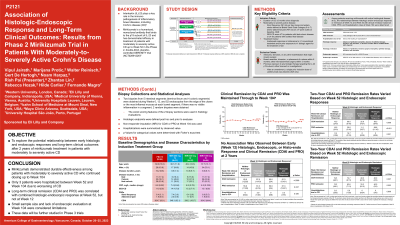Monday Poster Session
Category: IBD
P2121 - Association of Histologic-Endoscopic Response and Long-Term Clinical Outcomes: Results From Phase 2 Mirikizumab Trial in Patients With Moderately-to-Severely Active Crohn’s Disease
Monday, October 23, 2023
10:30 AM - 4:15 PM PT
Location: Exhibit Hall

Has Audio

Rish Pai, MD, PhD
Mayo Clinic
Scottsdale, AZ
Presenting Author(s)
Vipul Jairath, MBChB, DPhil1, Marijana Protic, MD, PhD2, Walter Reinisch, MD3, Gert De Hertogh, 4, Noam Harpaz, 5, Rish Pai, MD, PhD6, Zhantao Lin, 2, Rebecca Hozak, 2, Hilde Carlier, 2, Fernando Margo, 7
1Western University, London, ON, Canada; 2Eli Lilly and Company, Indianapolis, IN; 3Medical University of Vienna, Vienna, Wien, Austria; 4University Hospitals Leuven, Leuven, Antwerpen, Belgium; 5Icahn School of Medicine at Mount Sinai, New York, NY; 6Mayo Clinic, Scottsdale, AZ; 7Clinical Pharmacology Unit, São João University Hospital Center, Porto, Porto, Portugal
Introduction: We explored the potential relationship between early histologic and endoscopic responses on long term clinical outcomes after 2 years of mirikizumab (miri) treatment in a Phase 2 trial in patients with moderately-to-severely active Crohn’s disease (CD).
Methods: Patients were randomized 2:1:1:2 to 4 treatment arms: miri 1000mg, 600mg, 200mg, and PBO administered intravenously (IV) at W0, W4, and W8. Patients who received miri and achieved ≥1 point improvement at W12 in Simple Endoscopic Score for Crohn’s disease score were re-randomized to either continue their induction IV dose or receive miri 300mg subcutaneously every 4 weeks up to W52. Subjects reported to experience clinical benefit received 300mg SC from W52 to W104. Biopsies were obtained during endoscopy at W0, W12 and W52 from the edges of any ulcers or from the most inflamed mucosa in the terminal ileum and 4 colonic segments and were scored by blinded central readers. Endpoints were defined post-hoc and prior to analyses (see Table 1). Among patients receiving miri with active histological disease at baseline, we determined the relationship between histologic and/or endoscopic response or remission at W12 and W52 with clinical remission based on the Crohn’s Disease Activity Index (CDAI), patient-reported outcomes (PRO), and hospitalization rates at W104.
Results: W104, 56.9% patients (N=137) achieved CDAI remission vs 41.5% of 176 patients at W52. We observed no association between early (W12) histologic, endoscopic, or combined (histo-endo) response and clinical remission (CDAI & PRO) at 2 years. After 2 years, the percentage of patients achieving remission based on CDAI varied according to their response at W52 by histology (60%), endoscopy (25.9%), both histo-endo (56.3%), or neither (10.5%, p=0.006; Table 1). Similarly, the proportion of patients who achieved 2-year clinical remission (by CDAI) varied according to W52 remission by histology (72.7%), endoscopy (40%), both histo-endo (40%) or neither (19.5%, p=0.007). Hospitalization rates during this period were low and varied according to W52 response by histology (16.7%), endoscopy (0%), both (0%) or neither (3.9%, p=0.021).
Discussion: In CD patients treated with miri for 2 years, long term clinical remission (CDAI, PRO) was significantly correlated with histologic response alone as well as combined histologic-endoscopic response at W52, but not at W12. The small sample size was likely a limitation. This data will be further studied in Phase 3 trials.
Disclosures:
Vipul Jairath, MBChB, DPhil1, Marijana Protic, MD, PhD2, Walter Reinisch, MD3, Gert De Hertogh, 4, Noam Harpaz, 5, Rish Pai, MD, PhD6, Zhantao Lin, 2, Rebecca Hozak, 2, Hilde Carlier, 2, Fernando Margo, 7. P2121 - Association of Histologic-Endoscopic Response and Long-Term Clinical Outcomes: Results From Phase 2 Mirikizumab Trial in Patients With Moderately-to-Severely Active Crohn’s Disease, ACG 2023 Annual Scientific Meeting Abstracts. Vancouver, BC, Canada: American College of Gastroenterology.
1Western University, London, ON, Canada; 2Eli Lilly and Company, Indianapolis, IN; 3Medical University of Vienna, Vienna, Wien, Austria; 4University Hospitals Leuven, Leuven, Antwerpen, Belgium; 5Icahn School of Medicine at Mount Sinai, New York, NY; 6Mayo Clinic, Scottsdale, AZ; 7Clinical Pharmacology Unit, São João University Hospital Center, Porto, Porto, Portugal
Introduction: We explored the potential relationship between early histologic and endoscopic responses on long term clinical outcomes after 2 years of mirikizumab (miri) treatment in a Phase 2 trial in patients with moderately-to-severely active Crohn’s disease (CD).
Methods: Patients were randomized 2:1:1:2 to 4 treatment arms: miri 1000mg, 600mg, 200mg, and PBO administered intravenously (IV) at W0, W4, and W8. Patients who received miri and achieved ≥1 point improvement at W12 in Simple Endoscopic Score for Crohn’s disease score were re-randomized to either continue their induction IV dose or receive miri 300mg subcutaneously every 4 weeks up to W52. Subjects reported to experience clinical benefit received 300mg SC from W52 to W104. Biopsies were obtained during endoscopy at W0, W12 and W52 from the edges of any ulcers or from the most inflamed mucosa in the terminal ileum and 4 colonic segments and were scored by blinded central readers. Endpoints were defined post-hoc and prior to analyses (see Table 1). Among patients receiving miri with active histological disease at baseline, we determined the relationship between histologic and/or endoscopic response or remission at W12 and W52 with clinical remission based on the Crohn’s Disease Activity Index (CDAI), patient-reported outcomes (PRO), and hospitalization rates at W104.
Results: W104, 56.9% patients (N=137) achieved CDAI remission vs 41.5% of 176 patients at W52. We observed no association between early (W12) histologic, endoscopic, or combined (histo-endo) response and clinical remission (CDAI & PRO) at 2 years. After 2 years, the percentage of patients achieving remission based on CDAI varied according to their response at W52 by histology (60%), endoscopy (25.9%), both histo-endo (56.3%), or neither (10.5%, p=0.006; Table 1). Similarly, the proportion of patients who achieved 2-year clinical remission (by CDAI) varied according to W52 remission by histology (72.7%), endoscopy (40%), both histo-endo (40%) or neither (19.5%, p=0.007). Hospitalization rates during this period were low and varied according to W52 response by histology (16.7%), endoscopy (0%), both (0%) or neither (3.9%, p=0.021).
Discussion: In CD patients treated with miri for 2 years, long term clinical remission (CDAI, PRO) was significantly correlated with histologic response alone as well as combined histologic-endoscopic response at W52, but not at W12. The small sample size was likely a limitation. This data will be further studied in Phase 3 trials.
Disclosures:
Vipul Jairath: AbbVie – Advisory Committee/Board Member, consulting/advisory board fees, speaker’s fees. Alimentiv Inc – consulting/advisory board fees. Arena pharmaceuticals – consulting/advisory board fees. Asahi Kasei Pharma – consulting/advisory board fees. Asieris – consulting/advisory board fees. Astra Zeneca – consulting/advisory board fees. Bristol Myers Squibb – consulting/advisory board fees, speaker’s fees. Celltrion – consulting/advisory board fees. Eli Lilly and Company – consulting/advisory board fees. Ferring – consulting/advisory board fees, speaker’s fees. Flagship Pioneering – consulting/advisory board fees. Fresenius Kabi – consulting/advisory board fees, speaker’s fees. Galapagos – consulting/advisory board fees, speaker’s fees. Genentech – consulting/advisory board fees. Gilead – consulting/advisory board fees. GlaxoSmithKline – consulting/advisory board fees. Janssen – consulting/advisory board fees, speaker’s fees. Merck – consulting/advisory board fees. Metacrine – consulting/advisory board fees. Mylan – consulting/advisory board fees. Pandion – consulting/advisory board fees. Pendopharm – consulting/advisory board fees. Pfizer – consulting/advisory board fees, speaker’s fees. Prometheus – consulting/advisory board fees. Protagonist – consulting/advisory board fees. Reistone Biopharma – consulting/advisory board fees. Roche – consulting/advisory board fees. Sandoz – consulting/advisory board fees. Second Genome – consulting/advisory board fees. Shire – speaker’s fees. Sorriso pharmaceuticals – consulting/advisory board fees. Takeda – consulting/advisory board fees, speaker’s fees. Teva – consulting/advisory board fees. Topivert – consulting/advisory board fees. Ventyx – consulting/advisory board fees. Vividion – consulting/advisory board fees.
Marijana Protic: Eli Lilly and Company – Employee.
Walter Reinisch: 4SC – Advisory Committee/Board Member, Speakers Bureau. Abbott Laboratories – Advisory Committee/Board Member, Consultant, Grant/Research Support, Speakers Bureau. AbbVie – Advisory Committee/Board Member, Consultant, Grant/Research Support, Speakers Bureau. Aesca – Advisory Committee/Board Member, Consultant, Grant/Research Support, Speakers Bureau. Algernon – Consultant. AM Pharma – Advisory Committee/Board Member, Consultant. Amgen – Advisory Committee/Board Member, Consultant. AMT – Consultant. AOP Orphan – Consultant. Aptalis – Speakers Bureau. Arena – Consultant. Astellas – Advisory Committee/Board Member, Consultant, Speakers Bureau. AstraZeneca – Advisory Committee/Board Member, Consultant. Avaxia – Advisory Committee/Board Member, Consultant. Bioclinica – Consultant. Biogen IDEC – Advisory Committee/Board Member, Consultant. Boehringer Ingelheim – Advisory Committee/Board Member, Consultant. Bristol Myers Squibb – Advisory Committee/Board Member, Consultant. Calyx – Consultant. Celgene – Advisory Committee/Board Member, Consultant. Cellerix – Advisory Committee/Board Member, Consultant. Celltrion – Advisory Committee/Board Member, Consultant, Speakers Bureau. Centocor – Advisory Committee/Board Member, Consultant, Grant/Research Support, Speakers Bureau. ChemoCentryx – Advisory Committee/Board Member, Consultant. Covance – Consultant. Danone Austria – Advisory Committee/Board Member, Consultant, Speakers Bureau. DSM – Advisory Committee/Board Member, Consultant. Elan – Advisory Committee/Board Member, Consultant, Speakers Bureau. Eli Lilly – Consultant. Ernst & Young – Consultant. Falk Pharma GmbH – Consultant, Grant/Research Support, Speakers Bureau. Ferring – Advisory Committee/Board Member, Consultant, Speakers Bureau. Fresenius – Consultant. Galapagos – Advisory Committee/Board Member, Consultant. Gatehouse Bio – Consultant. Genentech – Advisory Committee/Board Member, Consultant. Gilead – Consultant. Grünenthal – Advisory Committee/Board Member, Consultant. ICON – Consultant. Immundiagnostik – Grant/Research Support, Speakers Bureau. Index Pharma – Consultant. Inova – Advisory Committee/Board Member, Consultant. Intrinsic Imaging – Consultant. Janssen – Advisory Committee/Board Member, Consultant, Grant/Research Support. Johnson & Johnson – Advisory Committee/Board Member, Consultant. Kyowa Hakko Kirin Pharma – Advisory Committee/Board Member, Consultant. Landos – Consultant. Lipid Therapeutics – Advisory Committee/Board Member, Consultant. LivaNova – Consultant. Mallinckrodt – Consultant. Medahead – Consultant. Medice – Speakers Bureau. MedImmune – Advisory Committee/Board Member, Consultant. Millenium – Advisory Committee/Board Member, Consultant. Mitsubishi Tanabe Pharma – Advisory Committee/Board Member, Consultant, Speakers Bureau. MSD – Advisory Committee/Board Member, Consultant, Grant/Research Support, Speakers Bureau. Nash Pharmaceuticals – Consultant. Nestle – Advisory Committee/Board Member, Consultant. Nippon Kayaku – Consultant. Novartis – Advisory Committee/Board Member, Consultant. Ocera – Advisory Committee/Board Member, Consultant. OMass – Consultant. Otsuka – Advisory Committee/Board Member, Consultant, Speakers Bureau. Parexel – Consultant. PDL – Advisory Committee/Board Member, Consultant, Speakers Bureau. Peri Consulting – Consultant. Pfizer – Advisory Committee/Board Member, Consultant. Pharmacosmos – Advisory Committee/Board Member, Consultant, Speakers Bureau. Philip Morris Institute – Consultant. PLS Education – Speakers Bureau. Procter and Gamble – Advisory Committee/Board Member, Consultant. Prometheus – Advisory Committee/Board Member, Consultant. Protagonist – Consultant. Provention – Consultant. Quell Therapeutics – Consultant. Robarts Clinical Trial – Consultant. Roland Berger GMBH – Consultant. Sandoz – Advisory Committee/Board Member, Consultant, Grant/Research Support. Schering-Plough – Advisory Committee/Board Member, Consultant, Speakers Bureau. Second Genome – Advisory Committee/Board Member, Consultant. Seres – Consultant. Setpoint Medical – Advisory Committee/Board Member, Consultant. Shire – Speakers Bureau. Sigmoid – Consultant. Sublimity – Consultant. Takeda – Advisory Committee/Board Member, Consultant, Grant/Research Support, Speakers Bureau. Teva – Consultant. Therakos – Advisory Committee/Board Member, Consultant, Speakers Bureau. Theravance – Consultant. TiGenix – Advisory Committee/Board Member, Consultant. UCB – Advisory Committee/Board Member, Consultant. Vifor – Consultant, Speakers Bureau. Yakult – Speakers Bureau. Zealand – Advisory Committee/Board Member, Consultant. Zygenia – Advisory Committee/Board Member, Consultant.
Gert De Hertogh: Centocor J&J – fees for clinical trial activities.
Noam Harpaz: Abbvie Inc – Advisory Committee/Board Member, Consultant. Bristol Meyer Squibb, Inc – Advisory Committee/Board Member, Consultant. Eli Lilly and Company – Advisory Committee/Board Member, Consultant. PathAI, Inc. – Advisory Committee/Board Member, Consultant.
Rish Pai: Seres Therapeutics, Eli Lilly, Protagonist, Genentech, and Robarts Clinical Trials. – Consultant.
Zhantao Lin: Eli Lilly and Company – Employee.
Rebecca Hozak: Eli Lilly and Company – Employee, Stock Options.
Hilde Carlier: Eli Lilly and Company – Employee.
Fernando Margo: Abbvie – Speakers Bureau. Arena – Speakers Bureau. Biogen – Speakers Bureau. Bristol-Myers Squibb – Speakers Bureau. Falk, Ferring, Hospira, Janssen – Speakers Bureau. Laboratórios Vitoria, Pfizer, Lilly, Merck Sharp & Dohme, – Speakers Bureau. Sandoz, Takeda, UCB, Vifor. – Speakers Bureau.
Vipul Jairath, MBChB, DPhil1, Marijana Protic, MD, PhD2, Walter Reinisch, MD3, Gert De Hertogh, 4, Noam Harpaz, 5, Rish Pai, MD, PhD6, Zhantao Lin, 2, Rebecca Hozak, 2, Hilde Carlier, 2, Fernando Margo, 7. P2121 - Association of Histologic-Endoscopic Response and Long-Term Clinical Outcomes: Results From Phase 2 Mirikizumab Trial in Patients With Moderately-to-Severely Active Crohn’s Disease, ACG 2023 Annual Scientific Meeting Abstracts. Vancouver, BC, Canada: American College of Gastroenterology.
